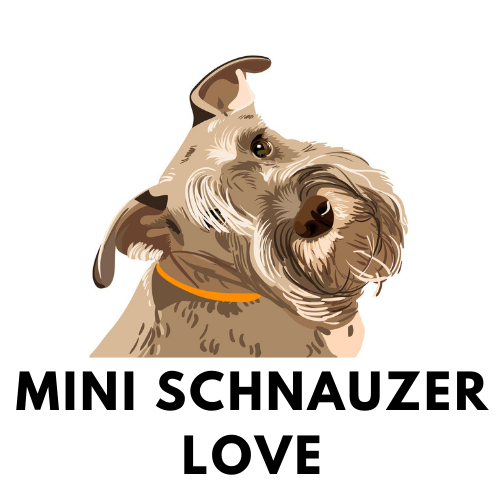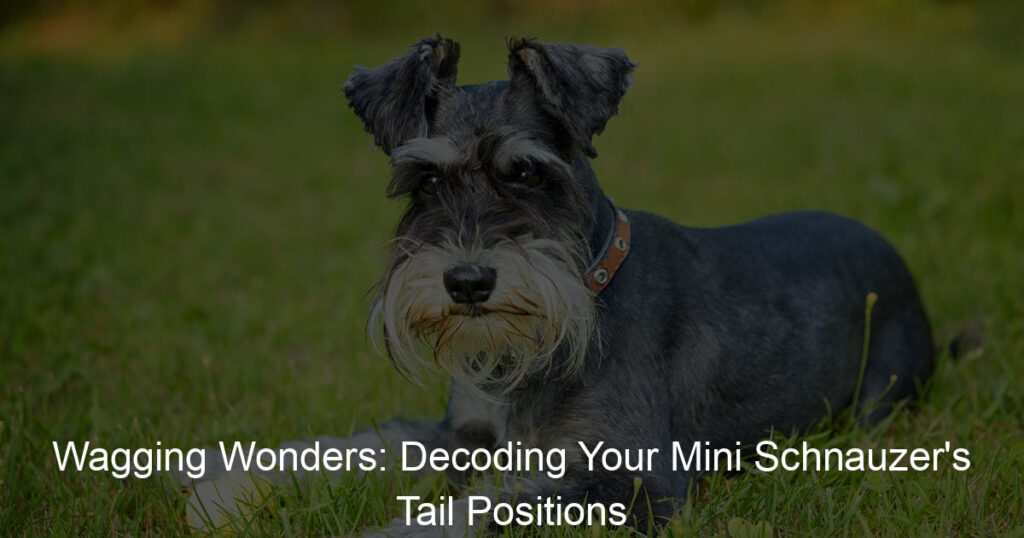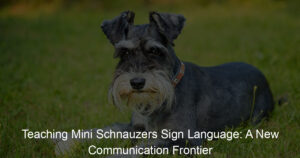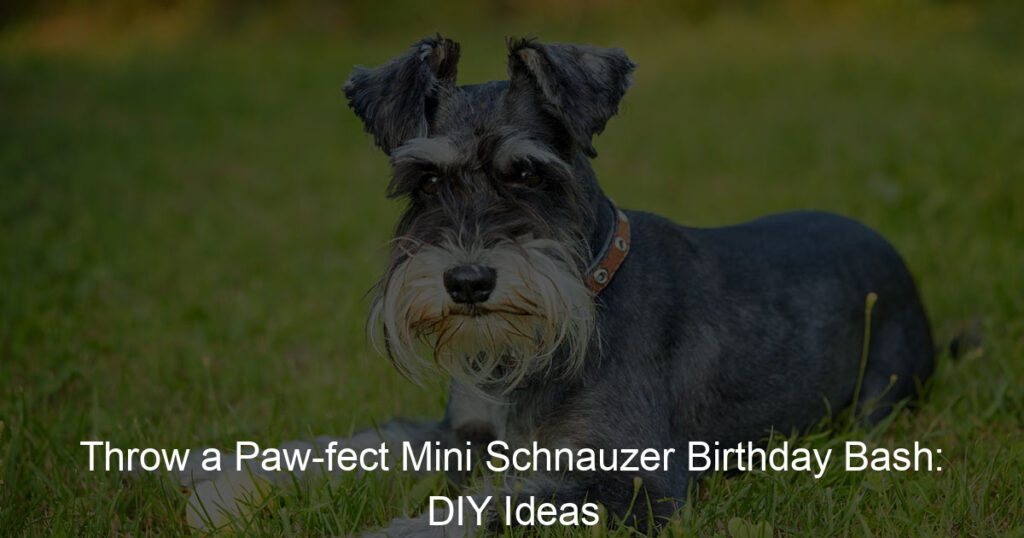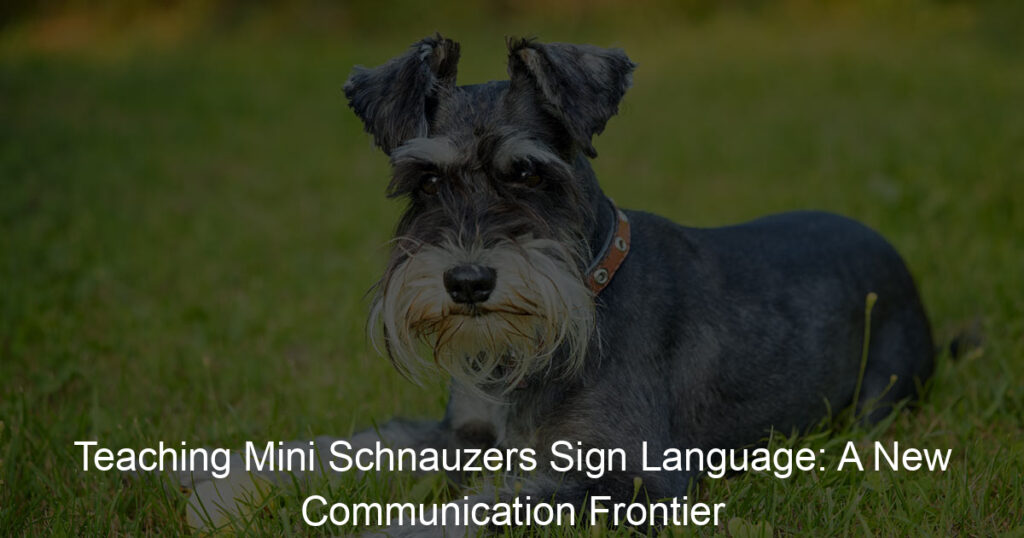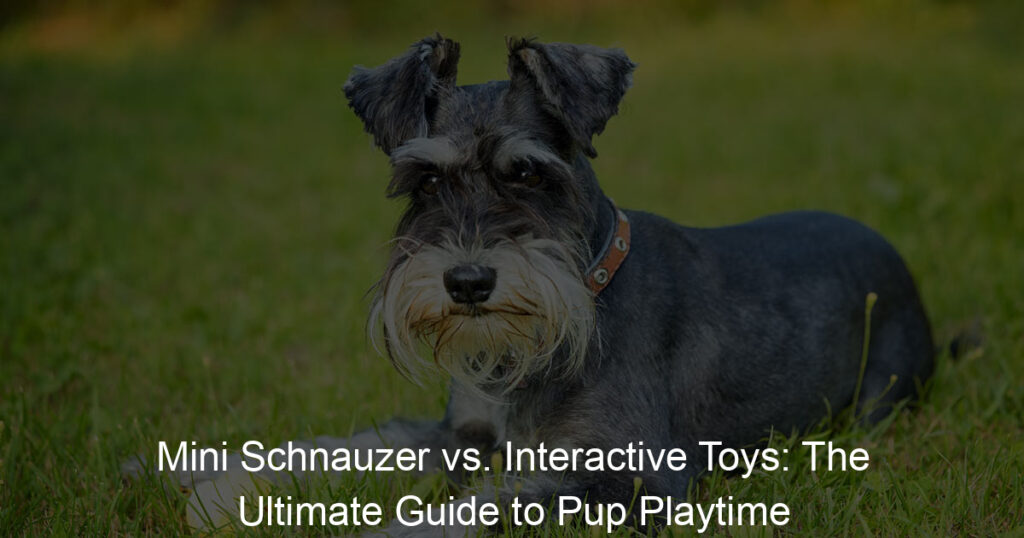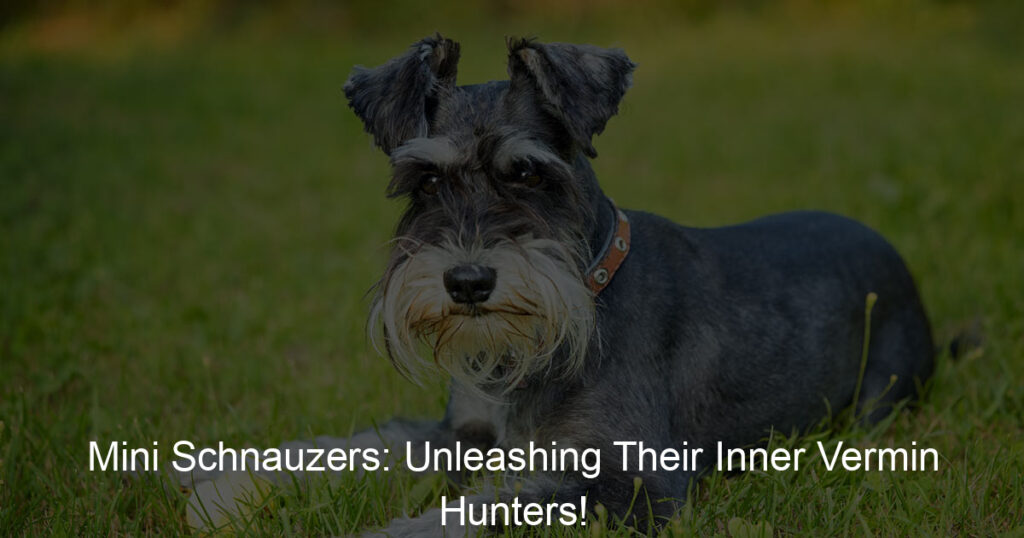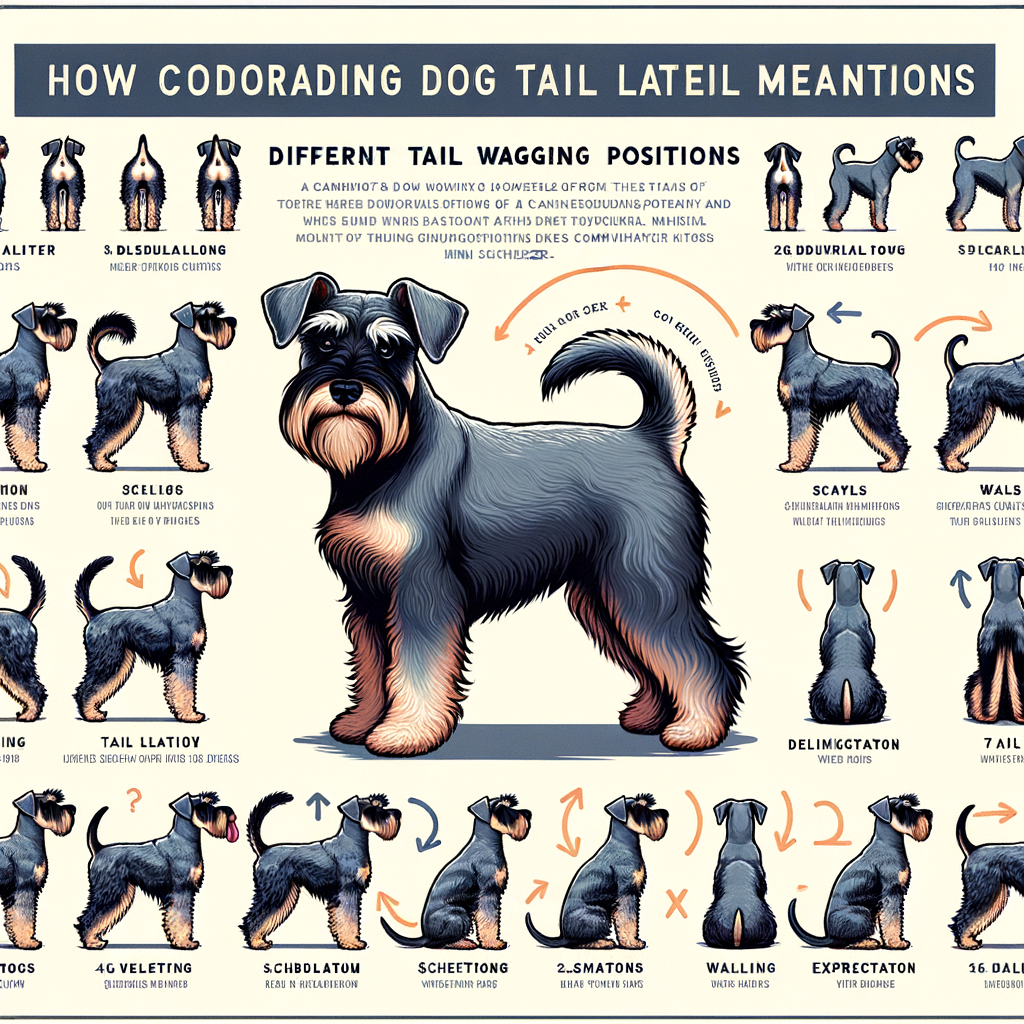
Introduction to Mini Schnauzer Tail Wagging
When it comes to understanding our furry friends, tail wagging plays a significant role. This is particularly true for Mini Schnauzers, a breed known for their expressive tails. This article will delve into the importance of tail wagging in dog communication, with a special focus on Mini Schnauzers.
- Understanding the importance of tail wagging in dog communication
Think of a dog’s tail as a communication antenna. It’s one of the primary ways dogs express their emotions and intentions. When a dog wags its tail, it’s trying to say something. It could be excitement, happiness, fear, or even aggression. Understanding these signals can greatly improve your relationship with your pet.
- Specifics of Mini Schnauzer tail wagging
Mini Schnauzers are known for their distinctive tail wagging. Unlike some breeds, their tails don’t just wag left and right. They also move up and down, and in circles. This gives them a wider range of signals to communicate with. For example, a high, stiff wag usually means they’re alert or excited. A low, slow wag might mean they’re unsure or nervous. And a fast, wide wag is usually a sign of happiness and friendliness.
It’s important to remember that every Mini Schnauzer is unique. They may have their own quirks and ways of expressing themselves. So, while these general guidelines can be helpful, it’s also important to pay attention to your own dog’s specific behaviors and patterns.
By understanding the importance of tail wagging and the specifics of Mini Schnauzer tail wagging, you can better understand your pet’s emotions and needs. This can lead to a stronger bond and a happier, healthier pet.
Decoding Dog Tail Positions: A General Overview
Understanding the language of our furry friends is a fascinating journey. Dogs communicate their feelings, intentions, and emotions through their body language, particularly their tail movements. This article aims to provide a comprehensive overview of dog tail positions and their meanings.
- Understanding dog body language
Dogs express their emotions and intentions through their body language. A wagging tail, a raised paw, a tilted head – each gesture has a unique meaning. By learning to understand these signals, we can better communicate with our canine companions and ensure their well-being.
- Dog tail wagging meanings
The tail wagging of a dog can mean many things. A fast, vigorous wag generally indicates happiness or excitement. A slow, stiff wag can indicate uncertainty or agitation. A tail held high and wagging fast might mean the dog is alert and assessing a situation, while a tail tucked between the legs often signifies fear or submission.
| Tail Position | Meaning |
|---|---|
| Fast, vigorous wag | Happiness or excitement |
| Slow, stiff wag | Uncertainty or agitation |
| Tail held high and wagging fast | Alertness |
| Tail tucked between legs | Fear or submission |
- Dog tail positions explained
Just like the wagging, the position of a dog’s tail also holds significant meaning. A raised tail indicates alertness or dominance, while a lowered tail often signifies relaxation or submission. A tail held straight out means the dog is curious and interested in something. Understanding these positions can help us better understand our dogs’ emotions and responses to different situations.
| Tail Position | Meaning |
|---|---|
| Raised tail | Alertness or dominance |
| Lowered tail | Relaxation or submission |
| Tail held straight out | Curiosity |
In conclusion, understanding the meaning behind our dogs’ tail positions and wagging can significantly enhance our communication with them. It allows us to respond appropriately to their needs and emotions, leading to a happier and healthier relationship.
Understanding Mini Schnauzer Behavior: Tail Positions
As a Mini Schnauzer owner, you may have noticed that your furry friend uses his tail to communicate. Understanding the meaning behind these tail positions can help you better understand your pet’s behavior and emotions.
Schnauzer Tail Positions: An In-depth Look
In this section, we will take a closer look at the different tail positions of a Mini Schnauzer and what they might mean. Remember, every dog is unique, and these interpretations might not always apply.
- Interpreting Mini Schnauzer tail movements
- Examples of common Schnauzer tail positions and their meanings
A Mini Schnauzer’s tail is a powerful communication tool. Here are some common tail movements and their likely interpretations:
| Tail Movement | Interpretation |
|---|---|
| Wagging rapidly | Excitement or happiness |
| Low and still | Fear or submission |
| High and stiff | Aggression or dominance |
Remember, context is key when interpreting your Mini Schnauzer’s tail movements. The same movement can mean different things in different situations.
Now, let’s look at some common tail positions of a Mini Schnauzer and their possible meanings:
| Tail Position | Meaning |
|---|---|
| Tail curled over back | Confidence or excitement |
| Tail tucked between legs | Fear or anxiety |
| Tail held straight out | Alertness or interest |
Again, these interpretations are not set in stone. Always consider the overall body language and the situation when interpreting your Mini Schnauzer’s tail positions.
Understanding your Mini Schnauzer’s tail positions can greatly enhance your bond with your pet. It allows you to respond appropriately to their emotional state, making them feel understood and loved.
Case Study: Real-life Examples of Mini Schnauzer Tail Wagging
Let’s take a look at some real-life examples to better understand the different ways a Mini Schnauzer might wag its tail and what each type of wagging could mean.
-
Case Study 1: Happy Wagging
Meet Bella, a 3-year-old Mini Schnauzer. When Bella sees her favorite toy, her tail starts to wag vigorously from side to side. This is a clear sign of her excitement and happiness. She wags her tail at a high speed, and it’s easy to see that she’s in a good mood. This is a classic example of happy wagging.
-
Case Study 2: Agitated Wagging
Next, we have Max, a 5-year-old Mini Schnauzer. When Max sees a stranger approaching his house, his tail wags in a different manner. It’s stiff and the wagging is more abrupt. This is a sign that Max is agitated and on high alert. He’s not necessarily aggressive, but he’s definitely not as relaxed as Bella was with her toy.
-
Case Study 3: Scared or Nervous Wagging
Lastly, let’s look at Daisy, a 2-year-old Mini Schnauzer. During a thunderstorm, Daisy’s tail wagging changes again. It’s tucked between her legs, and it wags in small, quick movements. This is a sign that Daisy is scared or nervous. The thunderstorm is causing her stress, and her tail wagging is a clear indicator of her emotional state.
These case studies show us that tail wagging can mean different things in different situations. By paying attention to the way your Mini Schnauzer wags its tail, you can gain a better understanding of its emotional state and respond accordingly.
Key Takeaways: Decoding Your Mini Schnauzer’s Tail Positions
As we conclude our exploration of Mini Schnauzer tail positions, it’s important to summarize the key insights we’ve gathered. Understanding your Mini Schnauzer’s tail positions can significantly enhance your communication with your furry friend. Let’s recap:
- Understanding the importance of observing your Mini Schnauzer’s tail positions
- How to better communicate with your Mini Schnauzer through understanding their tail positions
Observing your Mini Schnauzer’s tail positions is crucial in understanding their emotional state. A high, stiff tail often indicates excitement or aggression, while a low or tucked tail can signal fear or submission. By paying close attention to these tail positions, you can better gauge your pet’s feelings and respond appropriately.
Understanding your Mini Schnauzer’s tail positions can greatly improve your communication with them. For example, if your Mini Schnauzer’s tail is wagging rapidly, they might be excited to see you. On the other hand, a slow, low wag could mean they’re feeling unsure or nervous. By recognizing these signals, you can respond in ways that reassure your pet and strengthen your bond.
Remember, every Mini Schnauzer is unique, and their tail positions might not always match the general guidelines. The key is to spend time with your pet and observe their behavior in different situations. Over time, you’ll become an expert in decoding your Mini Schnauzer’s tail positions, leading to a deeper and more fulfilling relationship.
| Tail Position | Meaning |
|---|---|
| High, stiff tail | Excitement or aggression |
| Low or tucked tail | Fear or submission |
| Rapid wagging tail | Excitement |
| Slow, low wag | Uncertainty or nervousness |
By understanding these key takeaways, you’re well on your way to becoming a more empathetic and effective Mini Schnauzer owner. Happy tail decoding!
Further Reading and Resources
If you’re eager to learn more about your Mini Schnauzer’s behavior and body language, there are a plethora of resources available. Here are some recommendations:
-
Books on Understanding Dog Body Language
Books are a great way to delve deeper into the subject. Titles like “Dog Language: An Encyclopedia of Canine Behavior” by Roger Abrantes, and “How To Speak Dog: Mastering the Art of Dog-Human Communication” by Stanley Coren, are excellent starting points. These books provide comprehensive insights into understanding your dog’s body language, including tail wagging.
-
Online Resources on Mini Schnauzer Behavior
There are numerous online resources that can help you understand your Mini Schnauzer’s behavior better. Websites like The American Kennel Club and The Miniature Schnauzer Club offer a wealth of information on this breed’s specific behaviors, including articles, blogs, and forums where you can interact with other Mini Schnauzer owners.
-
Professional Dog Trainers Specializing in Mini Schnauzers
If you’re looking for more personalized guidance, consider reaching out to a professional dog trainer. Many trainers specialize in specific breeds, including Mini Schnauzers. They can provide tailored advice and training techniques to help you better understand and communicate with your furry friend.
Remember, every dog is unique and may not always conform to general behavior patterns. Therefore, it’s important to observe and understand your Mini Schnauzer’s individual personality and behavior. Happy learning!
